Rail transport in New Zealand
| Rail transport in New Zealand | |||||||
|---|---|---|---|---|---|---|---|
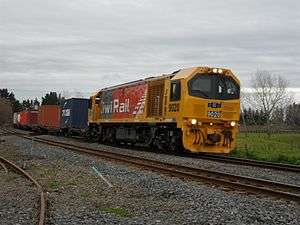 | |||||||
| Operation | |||||||
| National railway | KiwiRail | ||||||
| Infrastructure company |
New Zealand Railways Corporation (land) KiwiRail (track) Dunedin Railways Various heritage operators | ||||||
| Major operators |
The Great Journeys of New Zealand Transdev Wellington Transdev Auckland Dunedin Railways | ||||||
| Statistics | |||||||
| Ridership |
31.44m passengers per annum 19m Auckland commuter[1] 12.13m Wellington commuter[2] 0.31m KiwiRail Scenic[3] | ||||||
| Freight |
17.2m tonnes (2013–12)[3] 4.49m net tonne kilometres (2012–13)[3] | ||||||
| System length | |||||||
| Total | 4,128 km (2,565 mi) | ||||||
| Double track | 252 km (157 mi) | ||||||
| Electrified | 589 km (366 mi) | ||||||
| Freight only | 2,328 km (1,447 mi) | ||||||
| Track gauge | |||||||
| Main | 1,067 mm (3 ft 6 in) | ||||||
| 1067 mm | 4,128 km (2,565 mi) | ||||||
| Electrification | |||||||
| Main | 25kV AC | ||||||
| 25kV AC | 488 km (303 mi) | ||||||
| 1500V DC | 101 km (63 mi) | ||||||
| Features | |||||||
| No. tunnels | 150 | ||||||
| Tunnel length | 80 km (50 mi) | ||||||
| Longest tunnel |
Freight Kaimai tunnel 8,879 m (29,131 ft) Passenger Rimutaka tunnel 8,798 m (28,865 ft) | ||||||
| No. bridges | 1787 | ||||||
| Longest bridge |
Freight Rakaia river bridge 1,743 m (5,719 ft) Passenger Waiau river bridge 700 m (2,300 ft) | ||||||
| Highest elevation | 832 m (2,730 ft) | ||||||
| at | Pokaka, North Island Main Trunk | ||||||
| |||||||
| Part of a series on |
| Rail transport in New Zealand |
|---|
 |
Rail transport in New Zealand is primarily provided by KiwiRail and focused on bulk freight, with a small number of tourist orientated passenger services, such as the TranzAlpine, Coastal Pacific and Northern Explorer. The Dunedin Railways also operate tourist trains out of Dunedin, and a number of heritage operators run charter specials from time to time.
Urban rail services exist only in Auckland and Wellington. Rail in New Zealand has received significant and ongoing government investment since re-nationalisation in 2008, with both urban rail systems being upgraded and expanded although greater lengths of track have also been closed than in any other time in New Zealand.
History
Provincial period (1863-1876)
The railway network was initially constructed by the provincial governments of New Zealand from 1863 onwards. New Zealand's first public railway was opened in that year, running the short distance between Christchurch and the wharf at Ferrymead and built by the Canterbury Provincial Railways.[4] The Canterbury Provincial Railways were built to the broad gauge of 5 ft 3 in (1,600 mm).
In February 1867, Southland Province opened a branch from Invercargill to Bluff to the international standard gauge of 4 ft 8 1⁄2 in (1,435 mm).
Vogel Era
From 1870, the central government of Sir Julius Vogel proposed infrastructure including railway development to be funded by overseas loans of £10 million. The central government also adopted a national gauge of 3 ft 6 in (1,067 mm). The first narrow-gauge line was opened on 1 January 1873 in the Otago Province, the Port Chalmers Branch under the auspices of the Dunedin and Port Chalmers Railway Company Limited. Auckland's first railway, between Auckland and Onehunga, opened in 1873. Vogel also arranged for Brogdens of England to undertake several rail construction contracts, to be built by "Brogden's Navvies" recruited in England.
Central Government control (1876-1982)
Following the abolition of the provinces in 1876, railway lines were controlled by the central government, originally under the Public Works Department, and from 1880 under the New Zealand Railways Department. A Minister of Railways was responsible for the department, and was a member of the New Zealand Cabinet.
A few private companies built railways in New Zealand, including the New Zealand Midland Railway Company, Wellington and Manawatu Railway Company, Waimea Plains Railway, and Thames Valley and Rotorua Railway Company. Only the Wellington and Manawatu Railway Company, nationalised in 1908, achieved any measure of success, with the rest being purchased by the Government before completion of their intended railway lines.
The first major route was completed between Christchurch and Dunedin in 1878, later extended to Invercargill the following year. The North Island Main Trunk, linking capital city Wellington with largest city Auckland, opened in 1908 after 23 years of construction. At the network's peak in 1952, about 100 branch lines were operating. Large-scale closures of branch railway lines began in the 1960s and 1970s. The network was initially protected from road transport competition under the Transport Licensing Act 1931, but this protection was gradually eased until its total abolition in 1983, along with the deregulation of the land transport industry.
The networks of the North and South Islands were independent of one another until the introduction of the inter-island roll-on roll-off rail ferry service in 1962 by the Railways Department, now branded The Interislander.
Corporatised ownership (1982-1993)
In 1982, the Railways Department was corporatised into a new entity at the same time land transport was deregulated. The Railways Department became the New Zealand Railways Corporation. The Corporation embarked on a major restructuring, laying off thousands of staff and cutting unprofitable services. After the 1983 land transport deregulation there was substantial rationalisation of freight facilities; many stations and smaller yards were closed and freight train services were sped up, increased in length and made heavier, with the removal of guard's vans in 1987 and the gradual elimination of older rolling stock, particularly four-wheeled wagons.[5]
In 1987 the Railways Corporation became a state-owned enterprise, required to make a profit. In 1990, the core rail operations of the Corporation were transferred to New Zealand Rail Limited, a state owned enterprise, with the Corporation retaining non-core assets which were gradually disposed of, apart from a significant land portfolio (due to Treaty of Waitangi claims) which it continued to manage. New Zealand Rail Limited was privatised in 1993.
Private ownership: Tranz Rail (1993-2004)
Privatised in 1993, in 1995 the new owners adopted the name Tranz Rail. Rail freight volumes increased between 1993 and 2000 from 8.5m tonnes to 14.99m tonnes carried annually, and then gradually fell until 2003 to 13.7m tonnes.[6]
Tranz Rail was accused of deliberately running down some lines through lack of maintenance. The Midland Line for example, which mostly carries coal from the West Coast to Lyttelton, was assessed to be in a safe but poor state by the LTSA government safety body in 2003, and has needed major repairs.[7]
Tranz Rail was accused of forcing freight onto the roads, and in 2002 introduced a containerisation scheme that assumed that most freight would be carried in containers on unit trains made up of fixed consists of flat deck wagons. Container loading depots were constructed at the major freight terminals. One of the reasons often cited for these policies was that the cost of using road transport to Tranz Rail was less than that of using rail, because the road infrastructure is provided as a public good, whereas the rail network was a private good.[8]
Government purchase of Auckland rail network
The government purchased the Auckland metropolitan rail network from Tranz Rail for $81 million in 2002. Tranz Rail retained time slots for freight trains, and the Auckland Regional Council was granted slots for it to tender the operation of suburban passenger trains. Auckland railway stations not already local council owned were transferred to Auckland Regional Transport Network Limited (ARTNL), owned by the Auckland territorial authorities, which was merged with the Auckland Regional Transport Authority (ARTA), a subsidiary of the Auckland Regional Council (ARC).[9]
Private and government ownership: Toll and ONTRACK (2004-2008)
In 2003 the share price of Tranz Rail dropped to a record low on the New Zealand sharemarket[10] as a result of its poor financial state and credit downgrading.[11] The government then considered various schemes for bailing it out in return for regaining control of the rail infrastructure. Cited reasons included a "level playing field" for freight movements on road and rail, and ensuring access to the tracks for all interested parties.[8]
Toll Holdings of Australia made a successful takeover bid for Tranz Rail, subject to an agreement to sell back the infrastructure to the government for $1. This transaction took place in July 2004, and Tranz Rail was renamed Toll NZ. The government committed $200 million of taxpayer funding on deferred maintenance and capital improvements via a new subsidiary of the New Zealand Railways Corporation, ONTRACK. ONTRACK was then to negotiate rail access fees with Toll NZ, but these negotiations eventually fell into arbitration at the start of 2008.[12]
Renationalisation (2008-current)
In 2008 the government purchased from Toll NZ its rail and ferry assets for $690 million, effective 1 July 2008.[13] The name of the new organisation created to operate services on the rail network is KiwiRail.
KiwiRail released in 2010 a 10-year turnaround plan for the rail industry. This has been accompanied by significant government investment in KiwiRail of over $2.1 billion during the period 2008 to February 2017.[14] In May 2017, the government announced a further $450 million capital injection and that KiwiRail would be subject to a further significant review.[15] The plan has been significantly undermined by the Christchurch earthquakes of 2010 and 2011, the 2016 Kaikoura earthquake, Pike River Mine disaster, coal price collapse, Solid Energy going into voluntary administration in 2016 and major motive power issues with the new DL class of locomotives. Nevertheless, significant improvements in freight volumes have followed (other than with coal).[16]
Two of KiwiRail's major customers, Mainfreight and Fonterra, also invested heavily in rail-related infrastructure. Mainfreight has allocated $60 million for investment in new railhead depots, while Fonterra has invested $130m new rail hub complex in Hamilton and another planned for Mosgiel.[17]
Network ownership
Ownership of the national rail network is vested in KiwiRail Holdings Limited, with rail land owned by the New Zealand Railways Corporation. KiwiRail Network (formerly ONTRACK) is a division of KiwiRail that maintains and upgrades the rail infrastructure, and is responsible for the control of the network (i.e. train control and signalling). The primary operator is KiwiRail, which operates freight services (KiwiRail Freight) and long distance passenger services (KiwiRail Scenic Journeys). Other rail operating companies include Transdev Auckland and Transdev Wellington, who operate suburban services in Auckland and Wellington respectively, and Dunedin Railways, who operate tourist trains out of Dunedin.
Operations
Freight
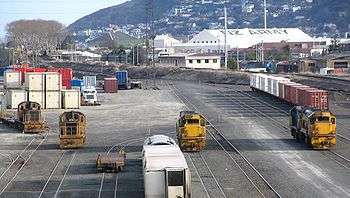
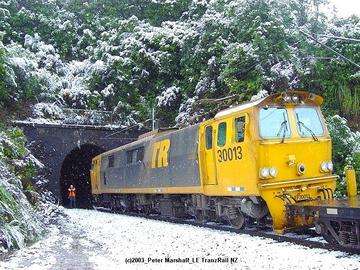

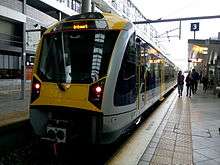

Freight operations are carried out by KiwiRail, and provides the overwhelming majority of revenue traffic. Freight is mostly bulk traffic geared towards export industries, with general freight being largely restricted to containerised and palletised products on the trunk route. Major bulk freight includes coal, lime, steel, wood and wood products, paper pulp, dry and liquid milk, cars, fertiliser, grain and shipping containers.[18]
Freight levels have returned to the level that they were at when the railway had a virtual monopoly, prior to 1983. In 1980 11.8 million tonnes of freight was moved by rail, in 1994 this had decreased to 9.4 million tonnes. By 1999 tonnes carried had increased to 12.9 million tonnes, slightly more than the 1975 peak.[19] In the 2006 – 2007 financial year, 13.7 million tonnes of freight were carried.[20] This equated to 3.96 million net tonne kilometres (or the amount of tonnes of traffic gained in 2008 – 2009 compared to the amount of traffic hauled in the 2006 – 2007 year) in the 2008 – 2009 financial year, about 15% of the total freight market.[21]
In recent years the amount of freight moved by rail has increased substantially, and started to gain market share in non-bulk areas as well. Freight on the North Island Main Trunk line between Auckland and Palmerston North saw an increase of 39% in freight volumes between 2006 and 2007. The five daily trains on the 667 km line reduced truck volumes on the route by around 120 per day.[22] In 2008, the government proposed to spend $150m to enlarge tunnels for the bigger ISO containers now operating.
A 2008 study by the Ministry of Transport predicted that by 2031 rail freight volumes would increase to 23 million tonnes per annum, or 70% on the 2006 – 2007 financial year.[20]
Long-distance passenger services
As of 2017, there are only four long-distance passenger routes: the Northern Explorer between Auckland and Wellington, the Capital Connection between Wellington and Palmerston North, the Coastal Pacific between Picton and Christchurch, and the TranzAlpine between Christchurch and Greymouth. All are operated by The Great Journeys of New Zealand (formerly KiwiRail Scenic Journeys), a division of KiwiRail, and are tourism focused (except for the Capital Connection, which is a commuter service). Passenger numbers are increasing and in 2017, KiwiRail Scenic Journeys relaunched as The Great Journeys of New Zealand and proposed an increase in carriage numbers.[23]
Dunedin Railways also operate tourist trains out of Dunedin, with frequent services on the former Central Otago line and occasional services north from Dunedin to Palmerston.
Mixed trains were "once the backbone of the New Zealand railway passenger system" on branch and even main lines; but the last scheduled mixed train ran between Whangarei and Opua on 6 June 1977. With a "rake of assorted wagons" and one or two passenger carriages, often listed as "goods with car" in timetables, they were slow, often stopping and shunting en route. In the 1930s they ran from Christchurch to Springfield on the Midland Line, and into the 1950s overnight between Christchurch and Dunedin. On the North Island Main Trunk they ran during the day while the expresses ran at night. On the Okahukura-Stratford Line they lasted to the early 1970s.[24]
In the 1950s and 1960s, most provincial routes had railcar and locomotive-hauled passenger services. In 1965, 25 million passengers travelled by rail; by 1998 the number had decreased to 11.7 million.[19] A number of services came to an end in the early 2000s, including the Waikato Connection between Hamilton and Auckland, the Kaimai Express between Auckland and Tauranga, the Geyserland Express between Auckland and Rotorua, the Bay Express between Wellington and Napier, the Southerner between Christchurch and Invercargill and the Northerner night service between Auckland and Wellington.
Suburban passenger services
Currently, only Auckland and Wellington have suburban passenger services. In both cities the respective local governments own the suburban passenger rolling stock, and contract the operation of services to Transdev.
The Wellington suburban network has five lines: Johnsonville, Kapiti, Melling, Hutt Valley and Wairarapa. In 1938, Wellington became the second city (after the Christchurch service to Lyttelton) to have electric suburban trains, and from 1970 to 2014 was the only city with them.
From July 2016, the services have been operated by Transdev Wellington.[25] Prior to Transdev, KiwiRail's Tranz Metro division had the contract. Wellington's suburban rolling stock consists of electric multiple units, with diesel locomotive-hauled carriage trains used on the Wairarapa service. All of the rolling stock (except the diesel locomotives) is owned by Greater Wellington Rail Limited, a subsidiary of Greater Wellington Regional Council. Transdev Wellington contracts KiwiRail to provide and operate the required diesel locomotives.
Auckland's network consists of four lines: Southern, Eastern, Western and Onehunga. All services on these lines are provided by electric trains, the conversion from diesel being completed by the end of 2015[26] with the exception of the non-electrified section of track between Papakura and Pukekohe, where a diesel train shuttle service operates. For nine years Tranz Metro also operated the suburban passenger services in Auckland, however in mid-2004 Connex (later Veolia, now Transdev) won the contract to run them. In recent years the mothballed Onehunga Branch was reopened (2010)[27] and a new line was built (Manukau Branch, opened April 2012).[28] Recent major projects include electrification of the Auckland suburban network and the building of the City Rail Link. Most Auckland rolling stock is owned by Auckland Transport (AT) who fund all services.
In 2017 the new Labour government proposed to provide commuter rail in Christchurch, and to provide long-distance "commuter" services from Auckland to Hamilton and Tauranga.
Other cities (Christchurch, Dunedin, Invercargill and Napier-Hastings) once had suburban services, but they were withdrawn due to a lack of patronage. The Christchurch-Lyttelton suburban service was stopped in 1972, when passengers were down to "a busload". The last "boat train" for the ferry service to Wellington ran in 1976. The 10.5 km line to Lyttelton was electrified from 1929 to 1970. There were worker’s trains north to Rangiora; two in the morning and two in the afternoon. Dunedin had suburban trains to Port Chalmers and Mosgiel, withdrawn on 3 December 1982. The Invercargill to Bluff service stopped in 1967; in 1929 the sole Clayton steam railcar had been used. Trains ran the 12 miles (20 km) between Napier and Hastings but some were replaced by a NZR bus service in 1926, and soon they ceased altogether.[29]
Worker’s concession tickets had been introduced in 1897, initially for the Wellington-Hutt service, and extended next year to Auckland, Christchurch and Dunedin (and then between Westport and Waimangaroa). A 1979 NZR report "Time for Change" said that the Wellington suburban services revenue met only 26% of operating costs (Dunedin was 28%, Auckland 46%).[30]
School commuters
Up to the 1930s and 1940s pupils had to commute to larger towns for secondary education from places that only had a primary school; e.g. from rural Canterbury to Christchurch Technical High School. Ruth Naughton (born 1924) went to "Tech" from 1938 with four others from Springfield; two hours each way and so time to do “train prep” . The school carriage on the mixed train was divided into two halves, with a door between the boys' and girls' halves. Archie Brown (born 1927) also went to "Tech", as did Jimmy Dillon (born 1930) from Rolleston.[31] For 3½ years Sir Edmund Hillary commuted by train from Tuakau to Auckland Grammar School, a one hour and 40 minutes journey each way.[32]
The NZR offered season tickets for students from 1877 (paid for out of the Education budget) and from 1885 for students attending primary schools from a place lacking a local school. Richard Seddon and the Liberal Government were keen to place secondary education "within the reach of the poorest man in the Colony" with extension of the free passes in 1898 and 1909. School season passes increased from 8720 in 1899 to 29,705 in 1914-15, when one in seven primary and secondary students travelled by train. Some pupils reached home after dark in the winter, and had to milk cows before and after school. John Pascoe said that some children spend "up to six hours a day travelling" Usually boys and girls were segregated.[33]
Infrastructure and mechanical
Rail Network
The New Zealand rail network has around 4,128 kilometres (2,565 miles) of line,[34] of which about 506 kilometres (314 miles) is electrified. At the network's peak in 1953, some 5,689 kilometres (3,535 miles) of line was open.[35] There are currently 1787 bridges and 150 tunnels (totalling 80 km in length) on the rail network.[36]
The entire network is built to the 1,067 mm (3 ft 6 in) gauge, chosen due to the need to cross mountainous terrain in the country's interior and the lower cost of construction; see Vogel railways.[37][18] Difficult terrain meant that some lines took years to complete, and has necessitated a number of complicated engineering feats, notably the Raurimu Spiral and Rimutaka Incline (the latter no longer in use).
The network has been the subject of major upgrading works on a number of occasions. The most major of these were the Westfield Deviation of the North Island Main Trunk from Auckland to Westfield Junction via Panmure and Glen Innes, opened 1930, the Tawa Flat deviation in Wellington, opened 1937; the Rimutaka deviation to the Wairarapa, opened 1955; and the Kaimai deviation in the Bay of Plenty, opened 1978. All of these involved major tunnelling works, of close to 9 kilometres (5.6 miles) each in the two latter cases. Significant infrastructure improvements were also carried out on the North Island Main Trunk in the mid-1980s, some as part of the electrification scheme.
As part of the 10-year Turnaround Plan announced in 2010, a number of regional lines were placed under threat of closure:[38]
- All lines in Northland that form part of the North Auckland Line;
- The Stratford–Okahukura Line in Taranaki; (mothballed since 2009)
- The northern portion of the Wairarapa Line;
- The Gisborne – Napier section of the Palmerston North - Gisborne Line (mothballed due to storm damage north of Wairoa early 2012, mothballed Napier – Gisborne from October 2012)[39]
Signalling
Six signalling systems are used in New Zealand: automatic signalling rules (ASR), double line automatic (DLA), single line automatic (SLA), centralised traffic control (CTC), track warrant control (TWC), and station limits. Signals are of the colour light type and operate on speed signalling principals, i.e. signals tell the driver what speed they should proceed, but not necessarily the route they will take.[40] The Auckland suburban network is also equipped with European Train Control System (ETCS) Level 1 signalling and train protection.[41]
Motive power
From its inception until the 1950s, steam locomotives were the main motive power on New Zealand's railways. Two short sections of line were electrified at 1500 V DC – Arthur's Pass to Otira (electrified 1923), Christchurch to Lyttelton (1929), both which have since been decommissioned. Electrification of the Wellington suburban network at 1500 V DC began in 1938 with the Johnsonville Line, followed by the North Island Main Trunk (NIMT) as far as Paekakariki in 1940, and the Hutt Valley lines in 1953–55. The NIMT electrification was extended to Paraparaumu in 1983 and to Waikanae in 2011.
Dieselisation began in the late 1940s with shunting locomotives. The first mainline diesel locomotives, the English Electric DF class, was introduced in 1954, but it wasn't until the introduction of the DA class the following year that steam began to be seriously displaced in the North Island. The last steam locomotive to be built by NZR, JA 1274, was introduced into service in December 1956, and by 1967, steam had all but disappeared from the North Island. Steam remained in the South Island until November 1971, when the last seven JA locomotives that worked the Main South Line were withdrawn from revenue service, steam in the South Island having been displaced by the Dj class locomotive.
In 1988 25 kV AC electrification of the North Island Main Trunk (NIMT) between Palmerston North and Hamilton was commissioned, and a new generation of mainline electric locomotives, the EF class were introduced.
As part of KiwiRail's 10-year long-term plan, most new capital will be spent on locomotives, wagons and the Auckland – Wellington – Christchurch freight corridor.[42]
Couplings
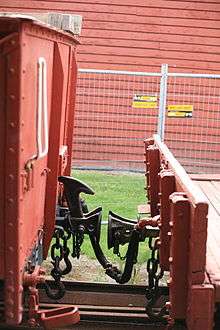
The Norwegian coupling was the standard coupler used in New Zealand for non-passenger rolling stock and locomotives until recent years. In the 1970s a large heavy-duty version of the chopper coupler was developed, initially for the class DX. Auckland's AM class and Wellington's FP/FT class "Matangi" electric multiple units use the Scharfenberg coupling.
The Janney ("Alliance") coupler was first used on heavy coal trains and have been progressively introduced on newer rolling stock and rebuilt locomotives. A program of retro-fitting older rolling stock has been underway since 2013.[43]
Workshops
The New Zealand Railways Department had major workshops at Addington (Christchurch), Easttown (Wanganui), Hillside (Dunedin), Petone (Lower Hutt, near Wellington) then Hutt (Lower Hutt, near Wellington) and Newmarket then Otahuhu, (Auckland). All were progressively closed (mostly in the 1980s), leaving only Hutt Workshops still operating. A number of small maintenance depots also currently operate, for example at Addington, Christchurch.
Accidents
New Zealand's most serious rail disaster occurred on Christmas Eve 1953, during the visit of Queen Elizabeth II, when a lahar washed away the bridge at Tangiwai. 151 lives were lost when the bridge collapsed as a Wellington-Auckland express passenger train was crossing it.
Heritage rail
Heritage passenger services
Four heritage rail operators own and operate their own carriage and mainline-certified steam or diesel locomotive fleets. These are the Railway Enthusiasts Society, Steam Incorporated, Mainline Steam Trust and the Otago Excursion Train Trust, . These groups have operated special excursion trains on the national network since 1978, and have been allowed to use suitable locomotives to haul these trains since 1983. A small number of other groups have overhauled their own locomotives for main-line use with either heritage or KiwiRail passenger carriages.
Heritage and museum railways
About 60 groups operate rail heritage lines or museums, almost all members of the Federation of Rail Organisations of New Zealand. They include street tramways and bush tramways as well as railways. Large-scale rail preservation in New Zealand got underway in the 1960s when many steam locomotives were withdrawn and branch lines closed.
Rail museums in New Zealand usually focus on storage and displays of rolling stock with a short line of around 1 km in length on which trains are operated. This covers most of the historic rail groups in New Zealand. A smaller number of lines are operated as heritage railways, usually on a closed section of a former national network branch line. Typically these lines are longer, usually 5 km or more, and most of their activities are focused on train operations with less emphasis on display and storage.
Current operations of the heritage railway type include the Kingston Flyer, Glenbrook Vintage Railway, Bush Tramway Club, Waitara Railway Preservation Society, Weka Pass Railway, and Dunedin Railways. The Dunedin Railways, which is a Local Authority Trading Enterprise (LATE) of the Dunedin City Council, runs the Taieri Gorge Limited is 60 km in length, making it the most ambitious project of its type to date. All other lines are operated by voluntary societies. The Weka Pass Railway at 13 km is the most lengthy of these. The Bay of Islands Vintage Railway is 11 km in length, but is in poor condition; having operated its first trains through Kawakawa since operations ceased in 2000 for two weeks from 3 July 2007, the Society is now working on rehabilitating the track between Kawakawa and Opua.
See also
Further reading
- Atkinson, Neil (2007). Trainland: How Railways made New Zealand. Auckland: Random House. ISBN 978-1-86941-905-9.
- Bromby, Robin (2003). Rails that built a Nation: An Encyclopaedia of New Zealand Railways. Wellington: Grantham House. ISBN 1-86934-080-9.
- Churchman, Geoffrey B; Hurst, Tony (2001). The Railways of New Zealand: A Journey through History. Wellington: Transpress. ISBN 0-908876-20-3. (1st edition 1990, 1991)
- Leitch, David; Stott, Bob (1988). New Zealand Railways: The First 125 years. Auckland: Heinemann Reed. ISBN 0-7900-0000-8.
- Millar, Sean (2011). The NZR Steam Locomotive. Wellington: New Zealand Railway and Locomotive Society. ISBN 978-0-908573-89-9.
- Sinclair, Roy (1987). Rail: The Great New Zealand Adventure. Wellington: Grantham House. ISBN 1-86934-013-2.
- Wright, Matthew (2003). Rails across New Zealand: A History of Rail Travel. Wellington: Whitcoulls. ISBN 1-87732-714-X.
References
- ↑ "An extra million on the trains in just three months" (Press release). Auckland Transport. 6 April 2017. Retrieved 8 June 2017.
- ↑ "Transport volume : Public transport volumes". New Zealand Ministry of Transport. Retrieved 10 March 2016.
- 1 2 3 "KiwiRail Annual Report 2014" (PDF). KiwiRail. Retrieved 7 November 2014.
- ↑ Stewart, W. W. (1974). When Steam was King. A. H. & A. W. Reed Ltd. p. 13. ISBN 0-589-00382-8.
- ↑ "Deregulation of rail in NZ". KiwiRail. July 2008.
- ↑ "New Zealand Freight Study" (PDF). Ministry of Transport. September 2008. Retrieved 10 January 2012.
- ↑ Land Transport Safety Authority (24 June 2004). "Rail safety report on South Island Coal Route". scoop.co.nz. Retrieved 23 January 2012.
- 1 2 Sharechat.co.nz (24 April 2003). "Tranz Rail a case for public private partnership". Retrieved 6 March 2012.
- ↑ beehive.govt.nz (25 July 2003). "Britomart opening".
- ↑ nzherald.co.nz (14 April 2003). "S & P, Moody's hit Tranz Rail".
- ↑ kiwirail.co.nz (1 July 2008). "History of rail: 2000 - Today".
- ↑ "Process for agreeing the purchase price for the Toll businesses" (PDF). 9 September 2008. Retrieved 9 January 2009.
- ↑ "KiwiRail funding since July 2008'". 10 March 2017.
- ↑ Templeton, Dan (26 May 2017). "New Zealand to invest almost $NZ 1bn in rail". International Railway Journal. Retrieved 21 June 2017.
- ↑ "Annual Report 2015-2016" (PDF).
- ↑ "KiwiRail survival plan is on track". The Dominion Post. 25 September 2010. Retrieved 25 September 2010.
- 1 2 Churchman, Geoffrey B. & Hurst, Tony (1991). The Railways of New Zealand: A Journey Through History (reprint ed.). HarperCollins Publishers (New Zealand).
- 1 2 "Statistics New Zealand - Long term data series - J Transport - J2 Rail - J2.1 Passengers and freight carried by rail.xls" (Excel). Retrieved 20 October 2009.
- 1 2 "National Freight Demands Study". July 2011. Retrieved 18 July 2011.
- ↑ "KiwiRail Express, October 2009 – Financial Report 2008 – 2009" (PDF).
- ↑ "Rail freight figures up". The New Zealand Herald. 17 August 2007.
- ↑ "KiwiRail may spend $50M on new carriages". 7 May 2017.
- ↑ Bromby, Robin (2003). Rails that built a Nation: An Encyclopaedia of New Zealand Railways. Wellington: Grantham House. pp. 120–121. ISBN 1-86934-080-9.
- ↑ "Wellingtons trains to be run by French company Transdev after KiwiRail loses contract". The Dominion Post. 17 December 2015. Retrieved 21 January 2016.
- ↑ "'Stunning' electric trains launched - but soon face delays". New Zealand Herald. 28 April 2014.
- ↑ "ARC chief unhappy at delay to new service". NZ Herald. 12 May 2010. Retrieved 31 January 2017.
- ↑ "New Auckland rail line opens". Radio New Zealand. 15 April 2012. Retrieved 31 January 2017.
- ↑ Bromby, Robin (2003). Rails that built a Nation: An Encyclopaedia of New Zealand Railways. Wellington: Grantham House. pp. 127–130. ISBN 1-86934-080-9.
- ↑ Bromby, Robin (2003). Rails that built a Nation: An Encyclopaedia of New Zealand Railways. Wellington: Grantham House. p. 128. ISBN 1-86934-080-9.
- ↑ Wright, Matthew (2009). Journey to the Pass: Memories of the Midland Line. Templeton, Christchurch: Hilton Press. pp. 66, 70–73, 93. ISBN 978-0-473-14641-2.
- ↑ Johnston, Alexa (2013). Sir Edmund Hillary: An Extraordinary Life. Penguin Random House New Zealand Limited. pp. 20, 22, 23. ISBN 978-0143006466.
- ↑ Atkinson, Neil (2007). Trainland: How Railways made New Zealand. Auckland: Random House. pp. 78–82. ISBN 978-1-86941-905-9.
- ↑ "CIA – The World Factbook – New Zealand". Retrieved 18 September 2009.
- ↑ "ONTRACK – Golden Age of Rail".
- ↑ P. McGimpsey, J. Havemann and J. Sutcliffe Beca Carter Hollings & Ferner Ltd. (2009). "Promoting sustainability in New Zealand's rail system - NZ Transport Agency Research Report 370" (PDF).
- ↑ "Our Railway Gauge", The New Zealand Railways Magazine, Volume 3, Issue 2 (1 June 1928)
- ↑ Tracy Watkins (18 May 2010). "KiwiRail gets $250m initial boost". The Dominion Post.
- ↑ "KiwiRail to mothball Napier-Gisborne Line". KiwiRail. 2 October 2012.
- ↑ "New Zealand Signalling Overview". Hutt Valley Signals. 9 November 2013. Retrieved 6 November 2014.
- ↑ Dearnaley, Mathew (24 June 2014). "New trains made tardy by controls". The New Zealand Herald. Retrieved 6 November 2014.
- ↑ NZPA (23 May 2010). "Mixed reaction to KiwiRail spend".
- ↑ "Kiwirail looking overseas for couplings". 7 August 2013.
External links
| Wikivoyage has a travel guide for Rail travel in New Zealand. |
- Railway Stations from NZ History online (with Media Gallery)
- Rail Tourism from NZ History online (with Media Gallery)
- New Zealand Railways Magazine at the New Zealand Electronic Text Centre
- Regulation of Rail Transport in New Zealand
- Railways Act 2005

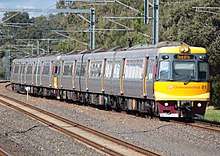
.svg.png)